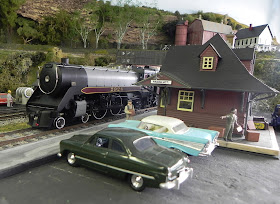As published in Sideroads Magazine
The local train station became the new community hub – a meeting place where farmers and millers would ship products, visitors could arrive without a grueling stagecoach ride, shops would receive efficient deliveries and residents might gather to get election results by telegraph.
 |
A scale model of the CVR station at Forks of the Credit, part of a model
landscape created by Erin rail enthusiast Steve Revell. Photo - Phil Gravelle
|
In 1908, Bolton became a major junction point for a new line running north through Palgrave and up to Sudbury – an all-rail route to the western provinces.
In order to reach Caledon Village, TG&B builders had to climb Caledon Mountain. They designed the Horseshoe Curve, where the rail line doubled back on itself to gradually gain altitude. Trains could only climb with five rail cars per engine.
The Great Horseshoe Wreck killed seven people in 1907 when a Canadian National Exhibition excursion special came down the Curve too fast and derailed.
The TG&B brought passenger rail service to Orangeville in 1871 and it was to last 100 years. Within six months, Orangeville was shipping up to 16 loads of grain a day as well as timber, lumber, and fence rails. In the 1880s a stagecoach ferried visitors to and from the railway station on Mill Street and the hotels and businesses along Broadway.
 |
A scale model of the Orangeville CPR station and rail yard
created by Steve Revell.
|
 |
The Orangeville CPR Station was moved to Armstrong Street in 1989
and is now home to the Barley Vine Rail Co. restaurant and bar.
Photo - Elizabeth Willmott
|
The TG&B was taken over by Canadian Pacific (CP) in 1884. In 1907, they built a new Orangeville station on the east side of the rail yard on Townline. The distinctive conical roof resembling a witch’s hat covered a waiting room that once had separate sections for men and women. It is one of only three stations in Canada constructed in this exact style.
In 1989, to avoid demolition, it was moved to Armstrong Street and converted to commercial use. The nearby rail yard bunkhouse and lunch bar, built in 1943, burned down in 2006.
Just past Orangeville was Fraxa Junction, where a northern branch of the TG&B carried on through Shelburne, reaching Owen Sound in 1873.
 |
A scale model of the Fraxa Junction station on the TG&B line
just west of Orangeville, created by Steve Revell. |
Elizabeth Willmot, in her book Meet Me at the Station, says people would gather along that line to see the Steamship Express headed north. This train was considered glamorous because passengers would later sail out of Owen Sound harbor, headed for Sault Ste. Marie.
About 10 miles north of Orangeville was Crombies station, a tiny board and batten building where travellers would wave a green and white flag to get trains to stop. It is preserved at the Dufferin County Museum.
 |
The Crombies flag stop station north of Orangeville.
Photo - Elizabeth Willmot
|
The Credit Valley Railway (CVR) served an area west of the TG&B. It had a route from Streetsville through Cheltenham, Inglewood and Alton, ending at Orangeville. Alton had a CVR station in the village, plus a TG&B station a mile’s walk away.
 |
CPR steam engine 183 rolls into Forks of Credit station in 1905.
The station was between the tracks and the road, near
the trestle bridge over the Credit River.
|
 |
The handsome brick union station in Inglewood, 1954, serving both
the CNR Milton and the CPR Streetsville subdivisions.
Published in Steam at Allandale by Ian Wilson, 1998.
Photo - Robert Sandusky
|
For the past 18 years, Cando Rail Services has used the old CVR route to run scenic Credit Valley Explorer excursions and freight deliveries between Orangeville and Mississauga. The firm recently announced it is ending these services, and a new operator is being sought.
The arrival of the railroad prompted incorporation of the Village of Erin in 1879. The simple wood frame train station was a combination passenger and freight depot, with a grain elevator and coal dealership nearby.
In the early 1900s it was often busy with train excursions for sporting events, dances, boating and cottaging at Stanley Park, a major tourist attraction.
 |
Erin CPR station in 1909, as published in Early History of the Township of Erin
by The Boston Mills Press.
|
The Hillsburgh station was built on the west side of the millpond created by the Gooderham and Worts dam. A station road and bridge had to be built over the dam to connect with the village.
 |
The Hillsburgh station and grain elevator in 1884.
Published in 1977 by The Boston Mills Press, in Steam Trains to the Bruce
by Ralph Beaumont.
|
 |
In its later years, the HIllsburgh station became a flagstop on the CPR branch
line from Cataract to Elora, which opened in 1879.
The rails were lifted in 1988.
|
Along what is now the Caledon Trailway, there were stations at Terra Cotta, Cheltenham, Caledon East, Centreville and Palgrave. There was a “union station” at Inglewood (Sligo Junction) where it intersected the Credit Valley line.
 |
The Caledon East Grand Trunk station in the mid-1950s.
Published in Steam Scenes of Allandale by Ian Wilson, 2007.
Photo - William Flatt
|
 |
Steam engine at Georgetown CN station in the 1950s.
Published in Steam Scenes of Allandale by Ian Wilson, 2007.
Photo - Keith Simon
|
 |
The Georgetown train station remains well used today.
|
The role of train stations has certainly changed, but they are key to understanding how small rural communities once flourished as industrial centres in a bold new country.



